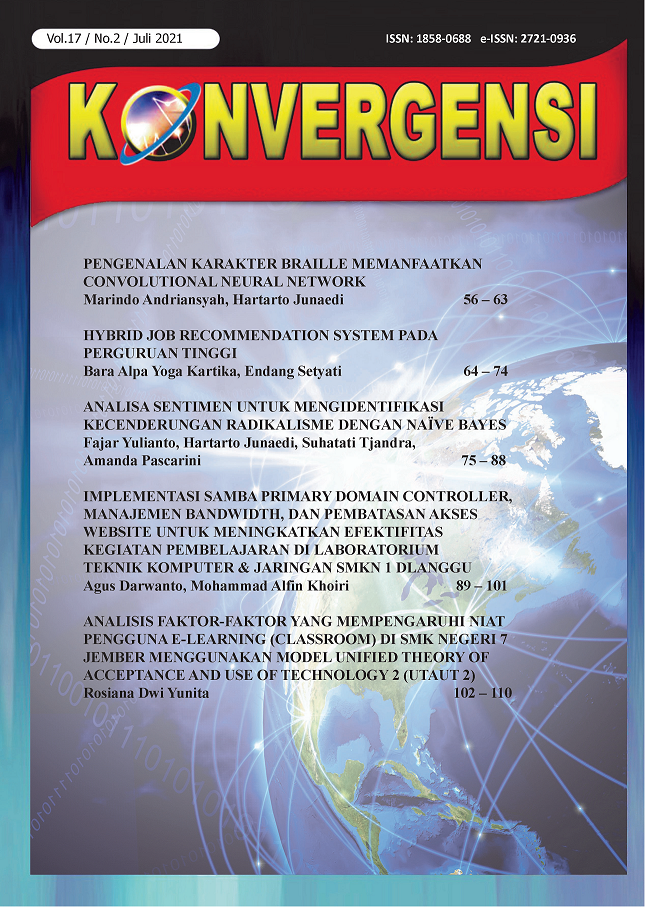PENGENALAN KARAKTER BRAILLE MEMANFAATKAN CONVOLUTIONAL NEURAL NETWORK
DOI:
https://doi.org/10.30996/konv.v17i2.5420Keywords:
Braille, CNN, Pengenalan KarakterAbstract
ABSTRACT
Braille is a character designed for the blind. Braille letters consist of six raised dots arranged in three rows and two columns. Braille is read by touch, so finger sensitivity is very important. Braille combinations need to be memorized, making them very difficult to learn. This study discusses the introduction of braille characters using the Convolutional Neural Network (CNN) method. CNN will process 3 data sets, 60, 100, and 150 data with each data using 5, 10, 25, and 50 epochs. The highest accuracy value in the training process is 99.87% with a loss value of 0.232. In the recognition process, the highest accuracy is 99.62% with a recognition error of 1 image out of 260 images.
Keywords: Braille, CNN, Character, Recognition.
ABSTRAK
Huruf braille merupakan karakter yang dirancang untuk orang buta. Huruf braille terdiri dari enam titik timbul yang tersusun dalam tiga baris dan dua kolom. Huruf braille dibaca dengan menggunakan sentuhan, oleh sebab itu sensifitas jari sangat penting. Kombinasi huruf braille perlu dihafalkan, sehingga sangat sulit untuk dipelajari. Penelitian ini membahas pengenalan karakter braille dengan menggunakan metode Convolutional Neural Network (CNN). CNN akan memproses 3 kelompok data, 60, 100, dan 150 data dengan masing-masing data menggunakan 5, 10, 25, dan 50 epoch. Nilai akurasi tertinggi pada proses traning sebesar 99.87% dengan nilai loss sebesar 0.232. Dalam proses pengenalan akurasi tertinggi sebesar 99.62% dengan kesalahan pengenalan 1 gambar dari 260 gambar.
Kata Kunci: Braille, CNN, Karakter, Pengenalan.
Downloads
References
A. F. Agarap, “Deep Learning using Rectified Linear Units (ReLU),” no. 1, pp. 2–8, 2018.
A. Giusti, D. C. Cireşan, J. Masci, L. M. Gambardella, and J. Schmidhuber, “Fast image scanning with deep max-pooling convolutional neural networks,” 2013 IEEE International Conference on Image Processing, ICIP 2013 - Proceedings, pp. 4034–4038, 2013.
W. Ma and J. Lu, “An Equivalence of Fully Connected Layer and Convolutional Layer,” no. 3, pp. 1–9, 2017.
A. S. Rawat, J. Chen, F. Yu, A. T. Suresh, and S. Kumar, “Sampled softmax with random fourier features,” Advances in Neural Information Processing Systems, vol. 32, no. 2, 2019.
Downloads
Published
Issue
Section
License
Authors whose manuscript is published will approve the following provisions:
- The right to publication of all journal material published on the Konvergensi Teknologi Informasi & Komunikasi website is held by the editorial board with the author's knowledge (moral rights remain the property of the author).
- The formal legal provisions for access to digital articles of this electronic journal are subject to the terms of the Creative Commons Attribution-ShareAlike (CC BY-SA) license, which means Konvergensi Teknologi Informasi & Komunikasi reserves the right to store, modify the format, administer in database, maintain and publish articles without requesting permission from the Author as long as it keeps the Author's name as the owner of Copyright.
- Printed and electronic published manuscripts are open access for educational, research and library purposes. In addition to these objectives, the editorial board shall not be liable for violations of copyright law.







